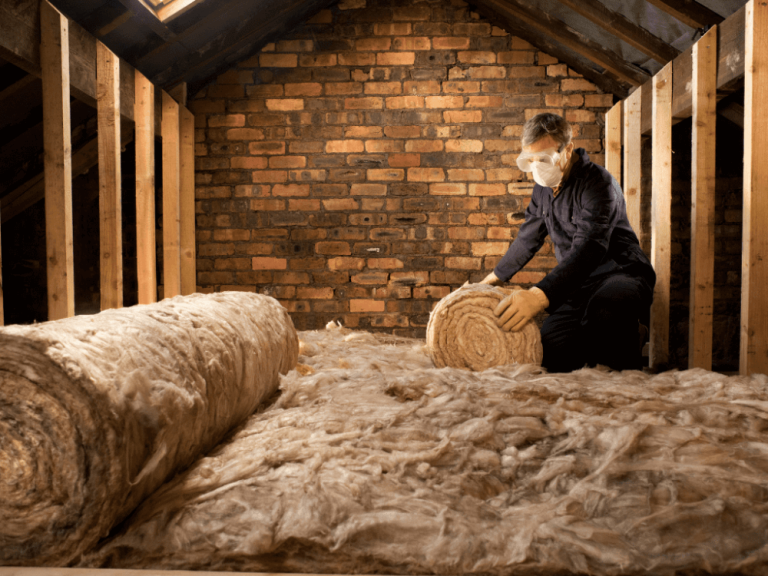Best loft insulation
Did you know that installing loft insulation can lower your energy bills by up to £315 per year?
Since heat rises, our homes lose around 25% of the warmth generated by our central heating systems through the roof. Loft insulation can prevent that from happening.
The walls (35%), windows, doors, and floors (40% collectively) are the other main culprits, so you should always ensure they are correctly insulated too.
Get A FREE Quote from local Specialists
Get quotes from local companies and tradespeople in your area and saving you up to 40% and dozens of hours on researching.
What does loft insulation do?
Insulation installed in your loft creates a thermal barrier to trap heat and prevent it from exiting through the roof. Not only does this save you energy, but it also prevents as many gases generated by your central heating from entering the environment.
Without this barrier, you will find it almost impossible to keep your home warm as the air will escape as soon as you can pump it through the house. You will end up paying huge bills and not benefitting from the heat. It is also not environmentally friendly, with more and more greenhouse gases being emitted as you try to stay warm.
Installing loft insulation can save you money and significantly lower your carbon footprint.
Types of loft insulation
There are four main types of loft insulation, batt or blanket insulation, loose fill insulation, sheet insulation, and blown-fibre insulation. Each has its purpose and associated pros and cons.
Within those types, different materials are used, including mineral wool, sheep’s wool, rock wool and recycled glass.
Batt/Blanket loft insulation
Perhaps the most common type of insulation, batt or blanket insulation comes in rolls of mineral fibre, rock, foil-backed felt, and recycled glass.
Pros
- Easy to install yourself
- Recycled glass is eco-friendly
- Sheep’s wool is non-irritant
- Can be used to insulate exposed wall cavities and other accessible spaces
Cons
- Sheep’s wool is a more expensive insulation material
- Some of the materials used are irritants, so you need to wear appropriate protection
- Blanket insulation can be too bulky to manoeuvre around obstacles or get in small spaces
Wickes has a range of Thermal Foil Insulation Rolls from (600mm x 8mm) for just £20 up to £125 for YBS SuperQuilt Multifoil 40mm Insulation Roll – 1.2 x 10m
You can also buy Premium SheepWool loft insulation in a soft grey, natural Thermafleece Sheeps Wool CosyWool Loft Insulation or SupaSoft Loft Insulation Roll in a range of sizes and thicknesses, from Insulation Superstore.
Get A FREE Quote from local Specialists
Get quotes from local companies and tradespeople in your area and saving you up to 40% and dozens of hours on researching.
Sheet loft insulation
Designed to insulate the sloping sides of the roof, sheet loft insulation comes in the form of rigid insulation boards.
These insulation boards can be precut to the size you need, although there is usually an extra cost for this service. They can also be made with a moisture or heat-resistant cover. Alternatively, the cover can be decorative to match your existing decor.
Pros
- Highly insulating per unit thickness
- Green insulation boards include straw, wood board, and cork
- Great for insulating loft conversions
- Optional plasterboard cover
- Some insulation boards have a built-in attachment
Cons
- Can be more expensive per insulation board than a different type of loft insulation
- The synthetic materials in some insulations boards require a lot of energy to produce
Loose-fill loft insulation
Loose-fill insulation is produced from a mix of lightweight materials such as granules, cork, cellulose fibre or mineral wool. Recycled newspaper is another material used in more eco-friendly loose-fill insulation.
Pros
- Greener materials can be used
- Can be fitted around obstacles
- Slots between irregularly spaced loft joists
- Can be used to top up existing insulation
Cons
- Risk of it coming loose if the loft is draughty
- Can be dangerous to instal – protective clothing and safety equipment are required
Blown-fibre insulation
As it sounds, this type of insulation is blown into the spaces between loft joists. This must be done by a professional contractor.
Pros
- A fast and simple job for a professional contractor
- You can ‘go green’ with recycled wool or paper
- Perfect for insulating hard-to-reach places
- Lightweight and easy to cut
Cons
- You do need a professional
- It can be an expensive type of loft insulation
- Not great for draughty lofts
FAQs
What insulation do I need?
That all depends on what you need it for. If you have a draughty loft, we wouldn’t recommend blown fibre insulation or loose-fill insulation.
If you are installing it yourself, your best bet is probably mineral wool insulation in blanket form, such as the Knauf Insulation Earthwool Acoustic Roll. This multifaceted product can be used to insulate the gaps between studs and joists, and internal walls and floors, and has many other applications. Rot proof, and made of non-combustible glass mineral wool quilt, it offers thermal and acoustic insulation and increases fire performance.
How thick should loft insulation be?
To keep warm and stop heat from escaping you usually want your blanket to be as thick as possible. The same applies to your loft insulation. If your loft is only ‘wearing’ a thin layer of insulation, it is going to let the cold in. This is why mineral wool and sheep’s wool are common materials for loft insulation as they reduce heat loss.
How much does it cost to insulate your loft?
Insulation materials are generally inexpensive and most lofts are not huge, even in a large house. You can usually have loft insulation work completed by a professional for a one-off fee of around £400.
Considering you can save around £300 a year, that’s a sound investment that could pay for itself many times over.
You can also buy inexpensive, easy-to-install blanket insulation and save money by installing it yourself or topping up your current loft insulation to reduce heat loss from the roof.
Where does the insulation go?
Loft installation doesn’t just sit there, it must be installed correctly between the floor joists and on the underside of the roof, between the rafters.
If you are on a tight budget or want to store materials sensitive to temperature fluctuations, you only need to insulate the floor joists to stop heat from getting into the loft. This is known as a ‘cold loft’ but is actually only cold in the winter and hot in the summer.
For a ‘warm loft’ you need to also insulate the underside of the roof, to stop the heat that has gotten into the loft from exiting the roof.
Is it safe to remove existing insulation?
In January 2022, The Residential Property Surveyors Association estimated that up to 250,000 homes could have spray foam insulation in their lofts and in almost every case it needed to be removed. Spray foam insulation was popular over the last 30 years or so but closed-cell spray foam seals the space, restricting airflow and causing condensation.
Eventually, the wooden roof supports can rot and disturb the supporting roof timbers too. This problem is leaving homeowners unable to pass roof safety surveys, preventing them from selling their homes.
If you have foam spray insulation installed expert advice is to have it removed asap. You will need to pay professional contractors to carry out the job.
Wet or damaged insulation should also be removed before you install new insulation.
If your current loft insulation is in good condition, topping it up with another layer won’t hurt.
Wickes has ‘Top Up’ rolls of glass mineral wool blanket insulation that carry the best possible Euroclass A1 reaction to fire classification. it is also an environmentally friendly option.
Can I install loft insulation by myself?
Competent DIYers can follow online tutorials to install most types of loft insulation between the floor joists. However, you will need a professional to insulate the roof.
What are some other benefits of loft insulation?
Not only does insulating your loft keep out the cold, but it also regulates the temperature of your house, helping it to stay warm in the winter and cool in the summer. This temperature regulation helps reduce your energy consumption and creates a more pleasant atmosphere. It could also be the first step in converting your loft.
Once it is insulated, you might want to use your loft as another living or storage space.
Loft conversions
Loft insulation can be installed as part of a loft conversion, potentially saving you money by combining jobs.
The cost of a loft conversion can vary dramatically depending on the level of building work required and the type of conversion. For example, a trussed roof loft conversion is one of the cheaper options, but the roof must match the minimum loft height for conversion.
If you have an unused attic room, you might want to look into a Velux loft conversion or a dormer loft conversion. Alternatively, bungalow owners can create extra living space with a bungalow loft conversion.
Those lucky enough to have high ceilings will know that it is harder to heat a large room with a high ceiling, with hot air rising and escaping. A Mansard loft conversion is an option to maximise space and make use of those high ceilings while adding proper insulation.
Lastly, a hip-to-gable loft conversion involves converting part of your roof into a loft space.
Find out everything you need to know about the different types of loft conversions and the related costs in our blogs.
Related products
You can buy Rockwool RWA45 Acoustic Insulation Slabs, which can be cut to the desired size and shape and installed where needed in your loft space. Water-repellent, durable, and requiring no maintenance, they are a time and energy-saving solution to reducing sound through insulation. This product is perfect for a gym, music studio or office loft conversion.
Get A FREE Quote from local Specialists
Get quotes from local companies and tradespeople in your area and saving you up to 40% and dozens of hours on researching.
Is there anything else I need to know?
Yes, condensation in a loft can make loft insulation far less effective, so make sure you check any windows are air-tight and that the space is properly ventilated and insulated. Condensation can cause mould and water damage while negating your loft insulation, so keep an eye on any problem areas.
Conclusion
Installing insulation in your loft can prevent heat escaping through the roof, keeping your house warm and reducing your energy bills.
The best loft insulation depends on several factors, including the type and size of your property and the task it is required to perform. Your budget and how green you wish to be will also affect your choice.
We hope you found this quick guide useful and feel more confident about your loft insulation options.
Remember to always get multiple quotes before hiring a contractor and read loft insulation reviews before purchasing any loft-insulating products. Also, check the energy performance certificate and ensure the products complies with the UK and Ireland Building Regulations requirements of non-combustible materials/products.
Get A FREE Quote from local Specialists
Get quotes from local companies and tradespeople in your area and saving you up to 40% and dozens of hours on researching.




